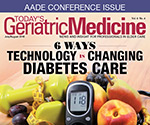 |
6 Ways Technology Is Changing Diabetes Care
Innovative products promise new strategies for treating type 2 diabetes. Read more »
Developing and Implementing Antibiotic Stewardship in Long Term Care
Implementing antibiotic stewardship in long term care requires leadership, education, commitment, accountability, and documentation. The resulting reduction in antibiotic resistance benefits patients, staff, and the community. Read more »
Questions on Calcium and Vitamin D Recommendations
Calcium and vitamin D have long been thought to play a key role in maintaining a healthy skeleton, but the mixed messages on recommendations are confusing to patients and clinicians alike. Read more » |
 |
 |
Managing Hypertension: An Important Update
I just knew it—you know how you feel when you know something is true but you don’t have the evidence to back it up?
Back in 2015 we discussed the Eighth Joint National Committee (JNC 8) guidelines and their recommendations for relaxing requirements for blood pressure-lowering targets in elders. That worried me. We know three of every four persons over the age of 75 have hypertension. And it is clearly established that higher levels of systolic blood pressure (SBP) are related to more cerebrovascular events and development of heart failure. This finding is outlined in the editorial on The Systolic Hypertension in the Elderly Program, which demonstrated that lowering SBP to less than 150 mmHg in patients aged 60 and older with isolated systolic hypertension was beneficial in reducing stroke, and the Hypertension in the Very Elderly Trial, involving patients aged 80 and older with hypertension and an SBP treatment target of less than 140 mmHg, showed significant reduction in the incidence of stroke and heart failure with active as compared with placebo therapy.1
Read more » |
 |
 |
Have a product or service you want to market to geriatricians, other physicians and the geriatric care team of professionals who treat aging patients? Are you a recruiter looking to fill the many geriatric professional openings within a facility, physician practice or academic institution? Then utilize the reach of Today's Geriatric Medicine to accomplish your marketing goals and fill any open positions.
Coming up in our September/October issue is our Fall Risk Showcase. Contact sales for more information.
A resource for professionals looking for new opportunities, as well as those physicians just curious to see what's out there, our Physician Recruitment Center gives physician recruiters a powerful tool to fill partnership opportunities, academic appointments, and hospital staff positions. To support your product marketing or recruiting needs, e-mail our experienced account executives today at sales@gvpub.com for more information or call 800-278-4400! |
 |
|
|
 |
Patient Wishes Are Tough to See
in Electronic Health Records
End-of-life wishes typically are difficult to find in patients’ electronic health records, according to an article in the Star Tribune of Minneapolis.
FDA Raises Questions About ‘Data Gaps’ Regarding Safety, Effectiveness of Hand Sanitizer
Are hand sanitizers safe and effective? The FDA expects to offer answers by September, according to an article in The Washington Post.
Vascular Surgeons Test Technology
That Lights the Way Through Blockages
An article in the Pittsburgh Post-Gazette notes that new technology can restore blood flow to relieve the pain and disability caused by peripheral artery disease.
Alzheimer’s Effects on the Brain
Found in Young People
In some people with at least one copy of the e4 variant most associated with an increased risk of developing Alzheimer’s disease, the hippocampus—the brain region involved with memory function—was found to be smaller even in those as young as 3 to 20 years old, according to an article in The Wall Street Journal. |
 |
 |
 |
Set up Job Alerts and create your online Résumé
to let potential employers find you today! |
 |
 |
 |
A Secure, Anonymous Résumé Bank
Job Alerts Sent to Your E-mail |
 |
 |
| Have a question you want answered by one of our experts? Send your question to TGMeditor@gvpub.com and it may be featured in an upcoming e-newsletter or print issue. |
 |
|


